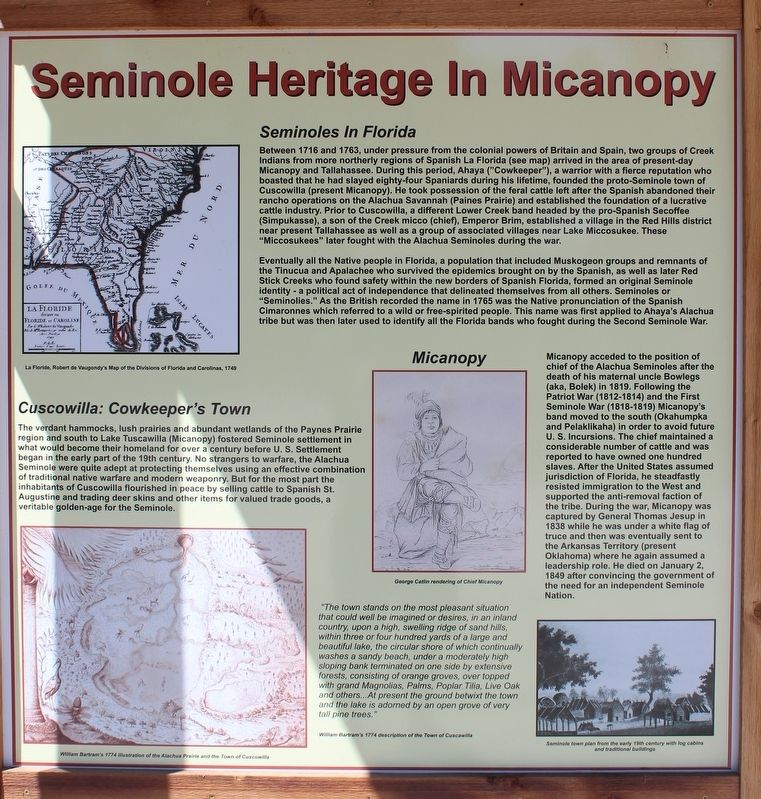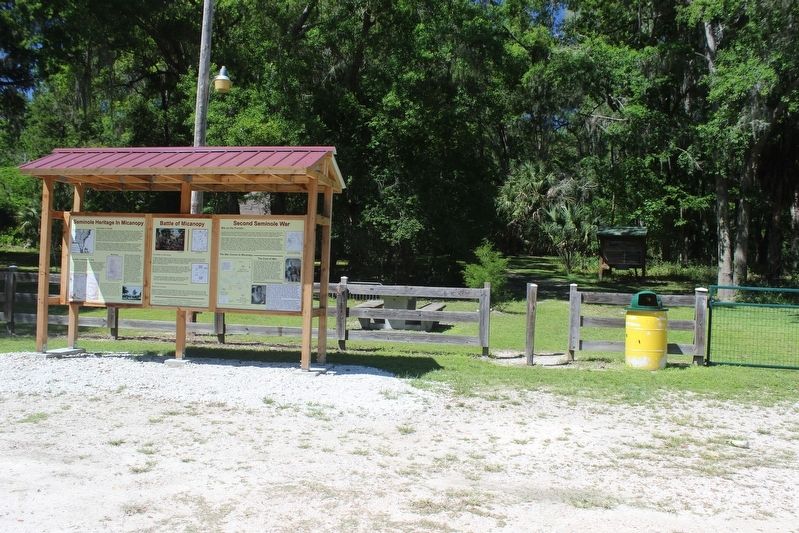Micanopy in Alachua County, Florida — The American South (South Atlantic)
Seminole Heritage in Micanopy
Seminoles in Florida
Between 1716 and 1763, under pressure from the colonial powers of Britain and Spain, two groups of Creek Indians from more northerly regions of Spanish La Florida (see map) arrived in the area of present-day Micanopy and Tallahassee. During this period, Ahaya ("Cowkeeper"), a warrior with a fierce reputation who boasted that he had slayed eighty-four Spaniards during his lifetime, founded the proto-Seminole town of Cuscowilla (present Micanopy). He took possession of the feral cattle left after the Spanish abandoned their rancho operations on the Alachua Savannah (Paines Prarie) and established the foundation of a lucrative cattle industry. Prior to Cuscowilla, a different Lower Creek band headed by the pro-Spanish Secoffee near present Tallahassee as well as a group of associated villages near Lake Miccosukee. These "Miccosukees" later fought with the Alachua Seminoles during the war.
Eventually all the Native people in Florida, a population that included Muskogeon groups and remnants of the Tinucua and Apalachee who survived the epidemics brought on by the Spanish, as well as later Red Stick Creeks who found safety within the new borders of Spanish Florida, formed an original Seminole identity-a political act of independence that delineated themselves from all others. Seminoles or "Seminolies." As the British recorded the name in 1765 was the Native pronunciation of the Spanish Cimaronnes which referred to a wild or free-spirited people. This name was first applied to Ahaya's Alachua tribe but was then later used to identify all the Florida bands who fought during the Second Seminole War.
Micanopy
Micanopy acceded to the position of chief of the Alachua Seminoles after the death of his maternal uncle Bowlegs (aka, Bloek) in 1819. Following the Patriot War (1812-1814) and the First Seminole War (1818-1819) Micanopy's band moved to the south (Okahumpka and Pelaklikaha) in order to avoid future U.S. Incursions. The chief maintained a considerable number of cattle and was reported to have owned one hundred slaves. After the United States assumed jurisdiction of Florida, he steadfastly resisted immigration to the West and supported the anti-removal faction of the tribe. During the war, Micanopy was captured by General Thomas Jesup in 1838 while he was under a white flag of truce and then was eventually sent to the Arkansas Territory (present Oklahoma) where he again assumed a leadership role. He died January 2, 1849 after convincing the government of the need for an independent Seminole nation.
Cuscowilla: Cowkeeper's Town
The verdant hammocks, lush parries and abundant wetlands of the Paynes Prairie region and south to Lake Tuscawilla (Micanopy) fostered Seminole settlement in what would become their homeland for over a century before U.S. Settlement began in the early part of the 19th century. No strangers to warfare, the Alachua Seminole were quite adept at protecting themselves using an effective combination of traditional native warfare and modern weaponry. But for the most part the inhabitants of Cuscowilla flourished in peace by selling cattle to Spanish St. Augustine and trading deer skins and other items for valued trade goods, a veritable golden-age for the Seminole.
"The town stands on the most pleasant situation that could well be imagined or desires, in an inland country, upon a high, swelling ridge of sand hills, within three or four hundred yards of a large and beautiful lake, the circular shore of which continually washes a sandy beach, under a moderately high sloping bank terminated on one side by extensive forest, consisting of orange groves, over topped with grand Magnolias, Plus, Poplar Tilia, Live Oak and others...At present the ground betwixt the town and the lake is adorned by an open grove of very tall pine trees."
William Bartram's 1774 description of the Town of Cuscawilla
Erected 2017 by Micanopy Trust for Historical Forts and Battlefields, Town of Micanopy, Gulf Archaeology Research Institute, Crystal River, FL, Micanopy Historical Society, Micanopy Chamber of Commerce, Nichols Lumber Company, Dunnellon, FL, Sandpiper Sign & Screen Print.
Topics. This historical marker is listed in these topic lists: Native Americans • Settlements & Settlers • Wars, US Indian. A significant historical year for this entry is 1716.
Location. 29° 30.155′ N, 82° 16.18′ W. Marker is in Micanopy, Florida, in Alachua County. Marker is on Southeast Tuscawilla Road, 0.3 miles west of U.S. 441, on the right when traveling west. Marker is located in the Micanopy Native American Heritage Preserve. Touch for map. Marker is at or near this postal address: 406 Southeast Tuscawilla Road, Micanopy FL 32667, United States of America. Touch for directions.
Other nearby markers. At least 8 other markers are within walking distance of this marker. Battle of Micanopy (here, next to this marker); Second Seminole War (here, next to this marker); Stagecoach Stop (approx. 0.6 miles away); William Bartram (approx. 0.6 miles away); Steamboat Chacala Anchor (approx. 0.6 miles away); Micanopy Veterans Memorial (approx. 0.6 miles away); Moses Elias Levy (approx. 0.6 miles away); Micanopy (approx. 0.6 miles away). Touch for a list and map of all markers in Micanopy.
Credits. This page was last revised on May 27, 2020. It was originally submitted on May 25, 2020, by Tim Fillmon of Webster, Florida. This page has been viewed 468 times since then and 127 times this year. Photos: 1, 2. submitted on May 25, 2020, by Tim Fillmon of Webster, Florida. • Bernard Fisher was the editor who published this page.

